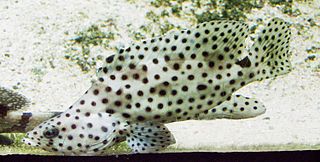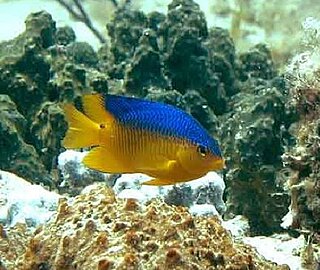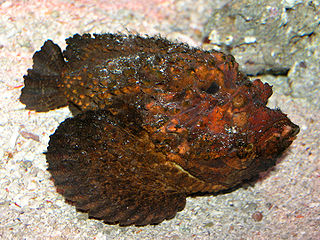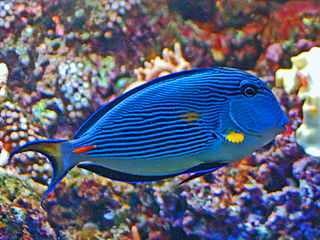
Sciaenidae is a family of ray-finned fishes belonging to the order Acanthuriformes. They are commonly called drums or croakers in reference to the repetitive throbbing or drumming sounds they make. The family consists of about 293 to 298 species in about 66 or 67 genera.

The Serranidae are a large family of fishes belonging to the order Perciformes. The family contains about 450 species in 65 genera, including the sea basses and the groupers. Although many species are small, in some cases less than 10 cm (3.9 in), the giant grouper is one of the largest bony fishes in the world, growing to 2.7 m in length and 400 kg (880 lb) in weight. Representatives of this group live in tropical and subtropical seas worldwide.

Pomacentridae is a family of ray-finned fish, comprising the damselfishes and clownfishes. This family were formerly placed in the order Perciformes but are now regarded as being incertae sedis in the subseries Ovalentaria in the clade Percomorpha. They are primarily marine, while a few species inhabit freshwater and brackish environments. They are noted for their hardy constitutions and territoriality. Many are brightly colored, so they are popular in aquaria.

Gouramis, or gouramies, are a group of freshwater anabantiform fish that comprise the family Osphronemidae. The fish are native to Asia—from the Indian Subcontinent to Southeast Asia and northeasterly towards Korea. The name "gourami", of Indonesian origin, is also used for fish of the families Helostomatidae and Anabantidae.

Cirrhitidae, the hawkfishes, are a family of marine perciform ray-finned fishes found in tropical seas and which are associated with coral reefs.

The Carangidae are a family of ray-finned fish that includes the jacks, pompanos, jack mackerels, runners, trevallies, and scads. It is the largest of the six families included within the order Carangiformes. Some authorities classify it as the only family within that order but molecular and anatomical studies indicate that there is a close relationship between this family and the five former Perciform families which make up the Carangiformes.

Synanceiinae is a subfamily of venomous ray-finned fishes, waspfishes, which is classified as part of the family Scorpaenidae, the scorpionfishes and their relatives. These fishes are found in the Indo-Pacific oceans. They are primarily marine, though some species are known to live in fresh or brackish waters. The various species of this family are known informally as stonefish, stinger, stingfish and ghouls. Its species are known to have the most potent neurotoxins of all the fish venoms, secreted from glands at the base of their needle-like dorsal fin spines. The vernacular name, stonefish, for some of these fishes derives from their behaviour of camouflaging as rocks. The type species of the family is the estuarine stonefish.

Eleotridae is a family of fish commonly known as sleeper gobies, with about 34 genera and 180 species. Most species are found in the tropical Indo-Pacific region, but there are also species in subtropical and temperate regions, warmer parts of the Americas and near the Atlantic coast in Africa. While many eleotrids pass through a planktonic stage in the sea and some spend their entire lives in the sea; as adults, the majority live in freshwater streams and brackish water. One of its genera, Caecieleotris, is troglobitic. They are especially important as predators in the freshwater stream ecosystems on oceanic islands such as New Zealand and Hawaii that otherwise lack the predatory fish families typical of nearby continents, such as catfish. Anatomically, they are similar to the gobies (Gobiidae), though unlike the majority of gobies, they do not have a pelvic sucker.

Anthias are members of the family Serranidae and make up the subfamily Anthiinae. The name Anthiidae is preoccupied by a subfamily of ground beetles in the family Carabidae created by Bonelli in 1813 and this grouping should be called the Anthiadinae. However, both the 5th Edition of Fishes of the World and Fishbase give the Serranid subfamily as "Anthiinae".

Haemulidae is a family of fishes in the order Perciformes known commonly as grunts. It is made up of the two subfamilies Haemulinae (grunters) and Plectorhynchinae (sweetlips), which in turn contain about 133 species in 19 genera. These fish are found in tropical fresh, brackish, and salt waters around the world. They are bottom-feeding predators, and named for the ability of Haemulinae to produce sound by grinding their teeth. They also engage in mutualistic relationship with cleaner gobies of genus Elacatinus, allowing them to feed on ectoparasites on their bodies.

Gudgeon is the common name for a number of small freshwater fish of the families Butidae, Cyprinidae, Eleotridae or Ptereleotridae. Most gudgeons are elongate, bottom-dwelling fish, many of which live in rapids and other fast moving water.

Oxyeleotris is a genus of sleeper gobies mostly restricted to Australia and New Guinea, though some are found in Southeast Asia.

The Gobiiformes are an order of fish that includes the gobies and their relatives. The order, which was previously considered a suborder of Perciformes, is made up of about 2,211 species that are divided between seven families. Phylogenetic relationships of the Gobiiformes have been elucidated using molecular data. Gobiiforms are primarily small species that live in marine water, but roughly 10% of these species inhabit fresh water. This order is composed chiefly of benthic or burrowing species; like many other benthic fishes, most gobiiforms do not have a gas bladder or any other means of controlling their buoyancy in water, so they must spend most of their time on or near the bottom. Gobiiformes means "goby-like".

Lutjanidae, or snappers are a family of perciform fish, mainly marine, but with some members inhabiting estuaries, feeding in fresh water. The family includes about 113 species. Some are important food fish. One of the best known is the red snapper.

Tetraroginae is a subfamily of marine ray-finned fishes, commonly known as waspfishes or sailback scorpionfishes, belonging to the family Scorpaenidae, the scorpionfishes and their relatives. These fishes are native to the Indian Ocean and the West Pacific. As their name suggests, waspfishes are often venomous; having poison glands on their spines. They are bottom-dwelling fish, living at depths to 300 metres (980 ft). These creatures usually live in hiding places on the sea bottom.

The Gobionellinae are a subfamily of fish which was formerly classified in the family Gobiidae, the gobies, but the 5th Edition of Fishes of the World classifies the subfamily as part of the family Oxudercidae. Members of Gobionellinae mostly inhabit estuarine and freshwater habitats; the main exception is the genus Gnatholepis, which live with corals in marine environments. The subfamily is distributed in tropical and temperate regions around the world with the exception of the northeastern Atlantic Ocean, the Mediterranean Sea, and the Ponto-Caspian region. It includes around 370 species and 55 genera: Wikipedia articles about genera list about 389 species.

Acanthurinae is a subfamily of marine ray-finned fishes belonging to the family Acanthuridae, found in the Indo-Pacific and the tropical Atlantic. These fishes commonly have the English names surgeonfishes or tangs.

Milyeringidae, the blind cave gobies, is a small family of gobies, in the order Gobiiformes. There are two genera and six species within the family, which is considered to be a subfamily of the Eleotridae by some authorities. Milyeringidae includes one genus (Milyeringa) restricted to caves in the North West Cape region of Australia and the other (Typhleotris) to underground water systems in Madagascar. They are all troglobitic species and have lost their eyes.

The Anabantiformes, collectively known as Labyrinth fish. are an order of air-breathing freshwater ray-finned fish with two suborders, five families and having at least 207 species. In addition, some authorities expand the order to include the suborder Nandoidei, which includes three families - the Nandidae, Badidae and Pristolepididae - that appear to be closely related to the Anabantiformes. The order, and these three related families, are part of a monophyletic clade which is a sister clade to the Ovalentaria, the other orders in the clade being Synbranchiformes, Carangiformes, Istiophoriformes and Pleuronectiformes. This clade is sometimes referred to as the Carangaria but is left unnamed and unranked in Fishes of the World. This group of fish are found in Asia and Africa, with some species introduced in United States of America.

Oxudercidae is a family of gobies which consists of four subfamilies which were formerly classified under the family Gobiidae. The family is sometimes called the Gobionellidae, but Oxudercidae has priority. The species in this family have a cosmopolitan distribution in temperate and tropical areas and are found in marine and freshwater environments, typically in inshore, euryhaline areas with silt and sand substrates.





















